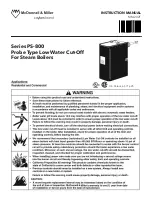
3. Do not store or use sources of hydrocarbons in the vicinity of the boiler. Sources of hydrocarbons
include bleaches, cleaners, chemicals, sprays, paint removers, fabric softeners and refrigerants.
4. Check safety relief valve for water leakage. If leakage exists, contact a qualified service agency.
B. Inspect Vent System (Monthly).
1. Vent pipe must be sealed and continuous with no separations, obstructions or sags.
2. Condensate drain trap (loop) must have sufficient water to maintain seal – add water to trap as
necessary.
C. Air Intake System (Monthly):
Pipe must be continuous with no separations, obstructions, or sags,
and secured with sheet metal screws.
D. Inspect Burner Flames (Monthly).
1. Adjust thermostat to highest setting. Verify operation follows Sequence of Operation (see page 2.)
2. View flames through observation port. See Figure 1.
3. Check burner flames. See Figure 3. Flames and flame reflection should be blue in color. If flames
extend below burners or are yellow and lazy, follow instructions TO TURN OFF GAS TO
APPLIANCE (see Figure 2), and contact a qualified service agency.
4. Adjust thermostats to normal setting.
E. Controls (as required by control manufacturer)
1
.
1. Safety Relief Valve. Conduct try lever test as outlined in manufacturer’s instruction tag on the
safety relief valve.
2. Low Water Cut-off (if used). Follow instructions provided by control manufacturer.
F. General Inspection and Maintenance (Annual).
For continued safe operation a qualified service
agency must provide a more detailed inspection of burners, heat exchanger and vent system, and
provide maintenance as specified in the Installation, Operation and Maintenance Manual.
6
Figure 3: Pilot and Main Burner Flames
1
Controls maintenance may be part of annual inspection and maintenance by a qualified service agency if annual frequency is
x
specified by controls manufacturer.
CAUTION
Vent system operates under positive pressure. Leakage in vent system will spill products of
combustion into building. Severe vent system leakage can cause carbon monoxide poisoning.
























